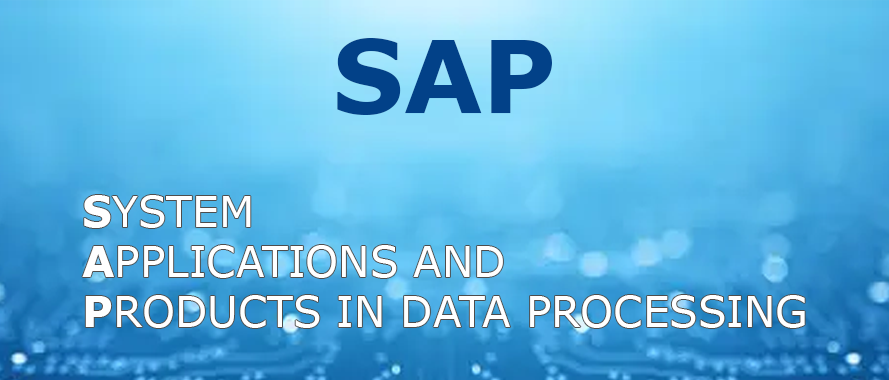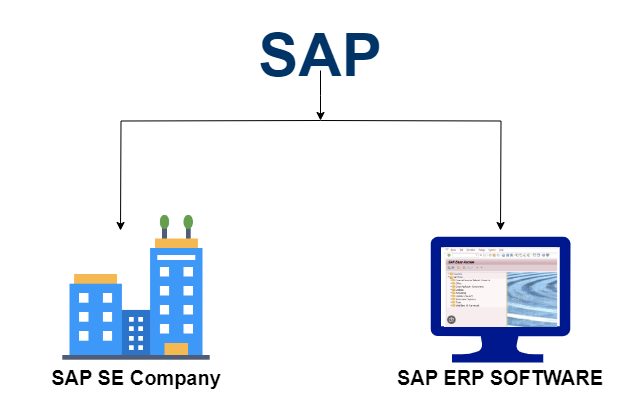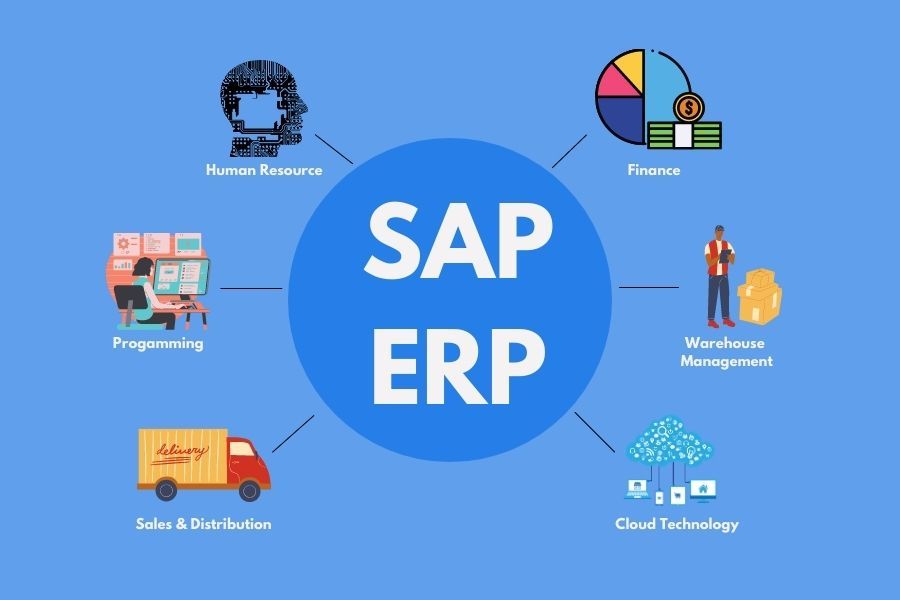SAP is a company that produces software primarily designed for managing businesses of all sizes.
SAP is a popular Enterprise Resource Planning (ERP) system used for various business applications. ERP software is recognized for its role in managing companies effectively.
The name SAP refers to the company headquartered in Waldorf, Germany, known for creating solutions such as Enterprise Resource Planning (ERP) software to help other companies operate effectively.
With SAP structure, data centralization, processing, visualization, and human resource management becomes easy and efficient.
What does SAP stand for? (What is SAP full form?)
SAP which stands for Systems, Applications, and Products in Data Processing, in German: Systeme, Anwendungen, Produkte in Der Datenverarbeitung

SAP SE Company:
SAP SE is a multinational company and the world's top software producer for business management and processes. SE stands for Societas Europaea. SAP SE is a public company that is registered in the corporate law of the European Union.
This article will discuss SAP and how it helps businesses reach market goals and profits.
What is an ERP?
The full form of ERP is Enterprise Resource Planning. It works to integrate many procedures into a single system. An ERP combines finance, supply chain, procurement, manufacturing, HR, service for creating business-related planning.
In the current era, ERP systems are essential to handle business-related work. Business owners can use ERP software to automate business-related activities such as procurement, risk management, CRM, project management, etc.

History of SAP
The initial startup of SAP was in 1972 by five former IBM employees intending to create standard application software for real-time business processing. Initially, they launched SAP with the original SAP R/2 and SAP R/3 software.
Over time, SAP established a global standard for Enterprise Resource Planning (ERP) software. According to the latest reports, SAP S/4HANA brings ERP to a new extent by using the power of in-memory computing for processing large data sets. It supports advanced technologies like artificial intelligence (AI) and Machine Learning (ML).
With SAP, it becomes easier for employees to access information and communicate with each other.
Thus, SAP allows firms to efficiently operate intricate business processes by providing employees of different modules with easy access to real-time insights across the business.
As a result, it increases workflows, enhances operational efficiency, boosts productivity, increases customer experiences, and eventually increases profits.
What does SAP do?
SAP is a software solution for all-sized businesses to manage trade operations and client relationships. The SAP framework consists of different completely coordinated modules. These cover all objectives and purposes in every outlook of commerce administration.
Businesses can map and design every process using standard SAP applications, platforms, enterprise solutions, and technologies. Using SAP software, one can collect and process data on one platform for better optimization, from basic material costs to production and client satisfaction.
Further, SAP allows clients to seamlessly merge operational data on business functions with customer experience data. These include customer feedback and purchase experience. It is a critical business characteristic to study market trends and customer requirements and thus facilitates companies to survey and cater to their customers.
SAP is one of the best ERP solutions in the market, including multiple fully integrated modules that cover every aspect of business management. Business holders can install SAP solutions "on-premise" at their location or use them from the cloud, allowing companies to explore and efficiently devise the whole value chain.
One can also create SAP solutions to automate tasks error-free.
What SAP Solutions are Available?
SAP offers solutions across a wide range of areas such as:
- ERP and Finance
- CRM and Customer Experience
- Network and Spend Management
- Digital Supply Chain:
- HR and People Engagement
- Experience Management
- Business Technology Platform
- Digital Transformation
- Small and Midsize Enterprises
- Industry Solutions

Benefits of SAP Software
- It helps to reduce the number of employees in the company and streamline its operations.
- Predicts the future scenarios speeds up all the latest business innovations and utilizes cloud ERP, which is beneficial for future generations.
- Increases the organization's efficiency by automating repetitive tasks.
- Creates a safer environment to keep the business secure from hackers, malicious attacks, etc.
- Provides security to make the user's data secured and safe from threats.
- It is a cross-platform i.e.: it can be operated on multiple platforms.
- Offers customized solutions for better usage.
- The system removes errors related to data duplication in both data analytics and report creation processes.
- Generates real-time reports about the company's current scenario, performance reports, and risk analysis.
- Increases the speed of decision-making.
- SAP system is also suitable for global business.
Disadvantages of using SAP:
- High costs: Generally, SAP is not for individual workers since the software is expensive. Thus, in most cases, companies and business firms use this to accomplish business processes.
- Complex Suite: SAP is complex and has difficult implementation. Thus, it also involves additional costs to the clients.
- Lengthy Implementation Time: Due to high implementations of large and complex data, the implementation time of SAP is too lengthy.
Reason to choose SAP:
We don't recommend using SAP if you are an individual worker because it is expensive software. SAP is best suited to corporate companies and businesses to achieve their goals. But if you have a business rather than a corporate job, you can use it to improve functionality. Many global multinationals such as Apple, coca-cola use SAP in their system.
How to Work with SAP Program?
For developing SAP, a business requires a new team which is called SAP consultants. This SAP consultant team will explain why a company needs SAP and provide training to the employees to work with SAP.
All the SAP's tasks are performed by GUI, i.e., graphical user interface and multi-tier architecture.
In SAP, GUI presents various screens to the users to read the information extracted from the database or enter the data. , it is very difficult for the new user to work with SAP. But, anyone can use SAP after having a good training session.
“SAP Activate” is the latest procedure to deploy SAP systems in a business. It uses old methodologies with new ones for the best results. SAP activate is a well-optimized implementation procedure for hybrid deployments, cloud, etc.
So here are the six major phases of implementation:
i) Discover the Requirements
In this phase, you have to determine the solution capabilities and benefits you can get by using SAP in your business. There is a free trial of SAP so that you can explore everything and understand the needs of your business.
It can help you to discover the requirements for implementing the SAP system for better decision-making.
ii) Prepare the Team
This phase requires the execution of the initial planning for implementing SAP in the business activities. You have to allocate the plans and assign responsibilities to the team member by providing them a starter system. Every team member needs good learning to use SAP, so they need to know a few things like:
- Project goals for the business
- Clear definition of roles and responsibilities
- High-level scope
- Effective governance to guide the project life-cycle.
Your planning will work as the backbone for the implementation of SAP. Hence, ensure that your projected planning is going smoothly and properly. As we have mentioned earlier, you can use the starter system of SAP to create the IDs of the team members.
iii) Explore the Situations
At this phase, use the fit-to-standard analysis for validating the solutions as per the project scope. This phase also confirms that the current scenario is meeting the business requirements.
According to our experience, you can schedule the workshop series with SAP consultants.
It can help you promote a productive analysis to find the predefined process and identify any required enhancement.
iv) Survey
After identifying all requirements, you can now use simple testing for building, and testing new integrated systems. At this phase, your team must start to load the data into the system. The team should develop cut-over plans and outline all adoption activities.
You have to survey the project life-cycle and explore every aspect of the SAP implementation in the business.
v) Deploy
This phase assumes that the company is ready to migrate its operations to a new environment. The team needs to define a specific learning plan and prepare for onboarding.
Besides that, the team has to outline the key tasks like non-transportable object setup, migration of data, and go/no-go decision points.
Once you complete these tasks and execute them properly, your business is ready to adopt the SAP cloud system.
vi) Run the System
Now, you can continue the starter system and implement everything across your entire business. First of all, start to add new users and encourage them to execute the business transactions and activate more functionalities of SAP.
Remember that the development team must run regression testing for the quarterly upgrades to work on the latest system.
Conclusion
So it was the brief details on SAP and why it is important for a business to achieve maximum profits. As we have mentioned above, SAP is essential for any business to combine multiple processes into a single system.
If you have a business and want to grow for achieving goals then you must go for SAP rather than any ERP system. There are various ERP systems available but SAP is the best software due to its amazing compatibility.
In the current business scenario, many companies are using SAP to improve their working environment. SAP offers a secure and flexible system that helps employees to work smoothly without having any issues.
